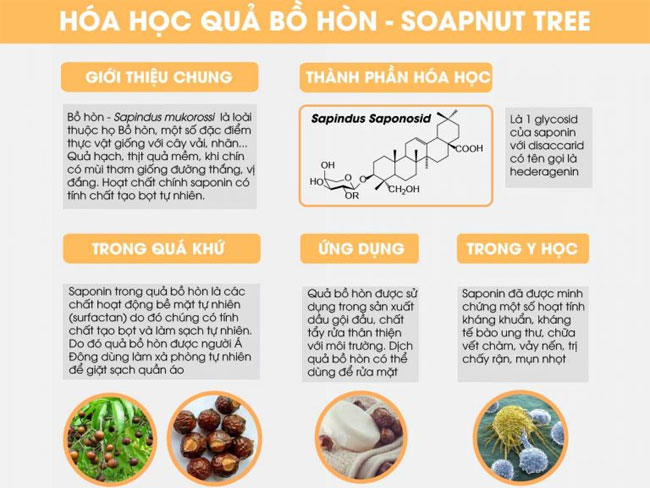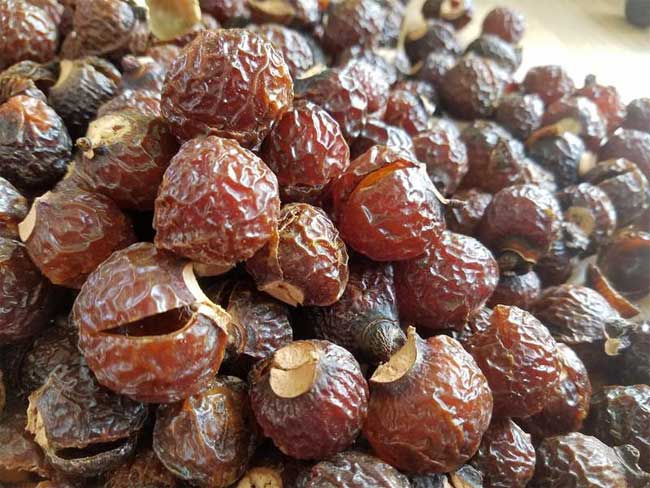If you know more about the benefits of the soapberry fruit, you can utilize its essence for cleaning your home, washing clothes, doing dishes, or bathing without the need for harmful chemicals that can damage your skin and health.
Learn About Soapberry
Soapberry contains saponin, a natural detergent that can help you clean clothes, maintain household hygiene, and even cleanse your body while bathing. You can purchase soapberry at an affordable price, and it can be used for most daily activities. These tips will help you save costs on buying shower gels and other cleaning products available in the market.
What is Soapberry?
Soapberry is the fruit of the soapberry tree, also known as bòn hòn, co hón, or mác hón, scientifically named Sapindus mukorossi Gaertn, belonging to the Sapindaceae family. There is a saying in folk wisdom: “Sucking soapberry makes you sweet,” implying that this fruit is extremely bitter, and those who suck on soapberry have a high tolerance for bitterness.

Soapberry water is safe, non-harmful to skin, and environmentally friendly, making it very popular.
The soapberry tree is large, with a wooden trunk that reaches an average height of about 5-10 meters, with some trees growing up to 13 meters. The leaves are compound, flat, pointed at the tips, and alternate, with leaflets visible on both the front and back sides. Flowers grow in clusters on the branches, are light green, and bloom from July to September.
The fruit is spherical with a thick skin, initially green when immature and turning brown-orange when ripe, containing dark brown seeds inside.
Today, due to its high cleansing properties, it is used as dishwashing liquid, soap, laundry detergent, and household cleaners instead of chemical cleaners. Soapberry water is safe, non-harmful to skin, and environmentally friendly, making it highly favored.
In medicine, it is also used to treat ailments, especially throat issues, oral problems, and skin diseases. Besides being used for humans, it is also applied to animals by crushing the bark and mixing it with water for bathing to treat lice and fleas. On average, soapberry fruits are harvested from October to December each year.
The soapberry tree is widely distributed across Asia: India, Malaysia, and Sri Lanka. However, in Vietnam, it is extensively cultivated in Phú Thọ, Vĩnh Phúc, Bắc Giang, and Thanh Hóa as it is seen as a substitute for soap.
Parts of the Soapberry Used
All parts of the soapberry tree are utilized, from the fruit and its skin to the leaves and roots, which have been researched for medicinal purposes or daily use. The fruits and seeds of soapberry are more commonly used through various methods, such as drying for traditional medicine.
Chemical Composition of Soapberry
The soapberry fruit contains a high percentage of saponins, accounting for up to 18% of saponosides. The fruit contains components such as saponosides A, B, C, D, E, E1, X, Y, and Y2, all of which have strong medicinal properties.
In addition to these chemical components, soapberry also contains about 9-10% fatty oil.

Uses of Soapberry
How to Use Soapberry for Bathing
The soapberry solution is gentle and suitable for almost all skin types, making it excellent for body cleansing. To utilize soapberry for bathing, you need to prepare the soapberry solution as follows:
Place about 25g of soapberry into 500ml of water. If you want a larger quantity of soapberry solution, you can increase the amount of water and soapberry in a ratio of 50g of soapberry to 1 liter of water.
- Boil the water and soapberry for 15-20 minutes. Remember to stir the water to release more saponin.
- Add one teaspoon of citric acid for each liter of water.
- Let the solution cool, then strain it to remove the soapberry residue.
Once you have the soapberry solution, you can use it as bath water, shampoo, or hand wash as follows:
- Mix cornstarch into the soapberry solution until you reach your desired thickness.
- Pour the mixture into a spray bottle for easy use.
The soapberry solution is a natural bathing liquid, so you need to use it quickly to avoid spoilage. You can store any unused solution in the refrigerator for longer shelf life.
Using Soapberry for Laundry
The benefits of soapberry extend beyond skin cleansing; it is also effective for cleaning fabrics. You can follow these steps to use soapberry for washing clothes in a washing machine:
- Place 5 soapberries in a fabric bag.
- Put the bag of soapberries along with your dirty laundry into the washing machine. Since soapberry is odorless, if you want your clothes to smell better, add a few drops of essential oil to the washing machine.
- Start the washing machine as usual. You can set it to warm water mode if washing a larger load.
After washing, remove the bag of soapberries to use again for future washes. You can use one bag of soapberries for about 4 washes.
If you prefer hand washing delicate fabrics, you can also use soapberry in the following way:
- Place soapberries in a basin of warm water and stir to release more saponin.
- Soak the clothes in the basin and begin washing.
Using Soapberry for Dishwashing
You can use soapberry to create a natural dishwashing liquid that protects your hands and health. The steps are as follows:
- Place about 4 soapberries in a fabric bag and soak the bag in warm water.
- Stir the water to release more saponin from the soapberries.
- Use this solution to wash dishes as usual.
Using Soapberry as Shaving Cream

The soapberry solution can help you clean foggy glass, yellowed sinks…
Shaving cream made from soapberry contains no harmful chemicals and can also help moisturize your skin. You can refer to the following method for using soapberry as shaving cream:
- Prepare the soapberry solution as you would for bathing.
- Mix the soapberry solution with a drop of olive oil, moisturizing oil, or a few drops of your favorite essential oil.
- Stir until the solution thickens, then store it in a sealed container.
- When using “soapberry shaving cream,” apply the mixture to your skin and shave as usual. Remember to stir the mixture before each use.
Using Soapberry as a Household Cleaner
The soapberry solution can help you clean foggy glass, yellowed sinks, or dirty floors. You can follow these steps to clean your home using the soapberry solution:
- Prepare the soapberry solution as instructed above.
- Mix the soapberry solution with vinegar in a 2:1 ratio and add a few drops of a disinfecting essential oil, such as tea tree oil or eucalyptus oil.
- Use this mixture as a substitute for cleaning water to wipe away stains in your home.
If you want to avoid harmful chemicals in dishwashing liquid or floor cleaners, you can use soapberry as a replacement. This natural fruit not only helps protect your health but is also very environmentally friendly.


















































